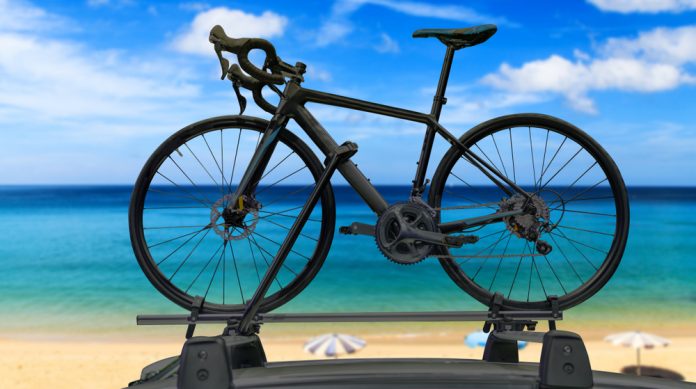For many racing cyclists and hobby cyclists the bike or bicycle carrier is an indispensable feature. For a short trip or a holiday – the bicycle has to come along. Bicycles take up a lot of space and therefore they must be placed on the car’s exterior.
 Industry offers several interesting solutions. The most common ones are:
Industry offers several interesting solutions. The most common ones are:
– roof carrier
– hatchback carrier
– tow-bar carrier
A properly installed quality-branded carrier ensures a safe and accident-free transport of your bicycle.
Function of the bicycle carrier
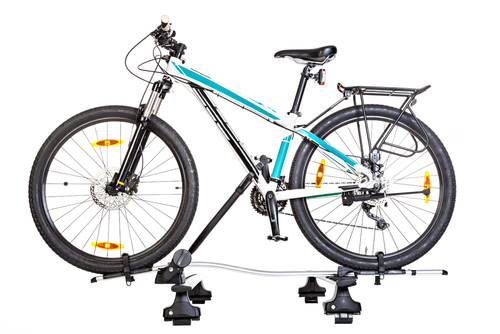 All three constructions have the same function. The bicycle wheels are placed on a rail and the bicycle is secured by fixing it to the carrier. A possibility for transport of children’s bicycles must be checked prior to purchase. Bicycle carriers save space in the boot and interior and provide additional safety as bicycles cannot be adequately secured in the interior. A bicycle becoming a dangerous projectile in case of sudden braking manoeuvres is thus avoided.
All three constructions have the same function. The bicycle wheels are placed on a rail and the bicycle is secured by fixing it to the carrier. A possibility for transport of children’s bicycles must be checked prior to purchase. Bicycle carriers save space in the boot and interior and provide additional safety as bicycles cannot be adequately secured in the interior. A bicycle becoming a dangerous projectile in case of sudden braking manoeuvres is thus avoided.
An important criterion for a bike carrier is its weight. The indicated maximum weight applies to the bicycles. The vertical load on the tow bar must be able to support the weight of the carrier plus bicycles. In case of roof racks, the roof load plays an important role, consisting of the weight of the bicycles plus the weight of the roof carrier. It must be said that hardly any carrier or bicycle will exceed the technical load of either tow bar or roof.
Furthermore for all construction applies: the test drive precedes the trip, enabling you to verify the proper attachment of the bicycles. Unintentional loosening can cause dangerous situations on the motorway.
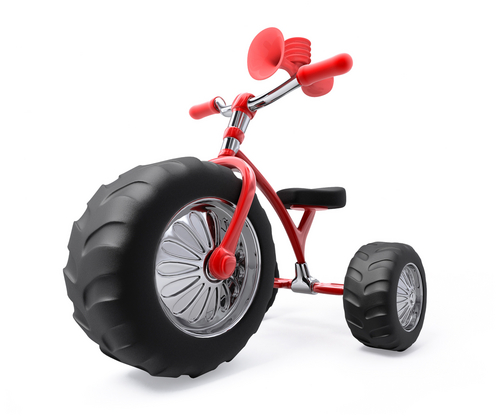 All common bicycles can be transported with a bike carrier. They are not suitable for small children’s bicycles, tricycles or tandems. Many racing bicycles and mountain bikes have to be additionally secured. The optimal distance between bicycles is 20 cm, preventing bicycles from damaging each other.
All common bicycles can be transported with a bike carrier. They are not suitable for small children’s bicycles, tricycles or tandems. Many racing bicycles and mountain bikes have to be additionally secured. The optimal distance between bicycles is 20 cm, preventing bicycles from damaging each other.
No specific permit applies to bicycle racks. Bicycles may usually be carried on the roof of a car, providing they are attached to an adequate roof rack and the total height does not exceed 4m.
Bikes can also be transported on the rear of a vehicle providing they do not obscure lights, blinkers or number plates. Bike racks can only rest on the tow bar if its maximum allowed vertical load is not exceeded. If crossing the Channel, be sure to inform yourself about the legal stipulations concerning the use of a bicycle carrier in other EU countries.
Adequate stability and plenty of space:
the roof rack
 Roof carriers are available for plenty of car types. Safe anchoring is essential for the mounting of a bicycle rack. Depending on car type the roof is equipped with rails allowing mounting of a bicycle carrier.
Roof carriers are available for plenty of car types. Safe anchoring is essential for the mounting of a bicycle rack. Depending on car type the roof is equipped with rails allowing mounting of a bicycle carrier.
A further installation option are retractable fixing points on the roof, intended for mounting the customised roof rack for your car. These are the base constructions for the bicycle carrier. If you don’t have fixing options, mounting a roof bicycle carrier is nevertheless an option. Certain roof carriers can be mounted without rails or fixing points. Some systems allow for clamping to the door frame and fixing with locking systems or adjusting screws.
Bicycles are generally transported standing on a roof carrier.
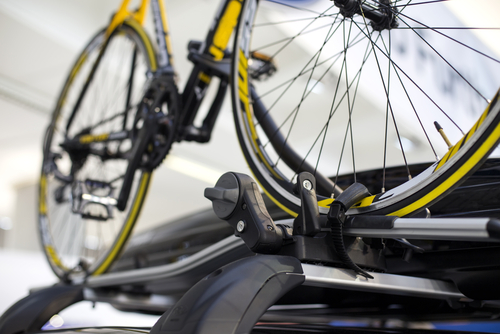 Alternatively, models enabling horizontal transport are available. These are especially suitable for distances where the free height above the roof is limited. Roof racks have up to three rails. The installation of a bicycle roof rack should be performed by two persons. Roof carriers with a lift are particularly practical, assisting the user with hoisting the bicycles.
Alternatively, models enabling horizontal transport are available. These are especially suitable for distances where the free height above the roof is limited. Roof racks have up to three rails. The installation of a bicycle roof rack should be performed by two persons. Roof carriers with a lift are particularly practical, assisting the user with hoisting the bicycles.
Roof carriers offer ample space, carrying up to four bicycles. Furthermore they do not hinder the rear view for the driver. A roof rack also enables the transport of broader bicycles. One of its disadvantages is the fact that it only allows the transport of lighter bicycles. Steering is influenced due to an increase in air resistance caused by the bicycles on the roof.
The maximum speed of 120 km/h must be observed. A roof rack increases fuel consumption with approximately 35 percent. Because of their weight, e-bikes are unsuitable for roof racks.
More stable and safe:
the hatchback carrier
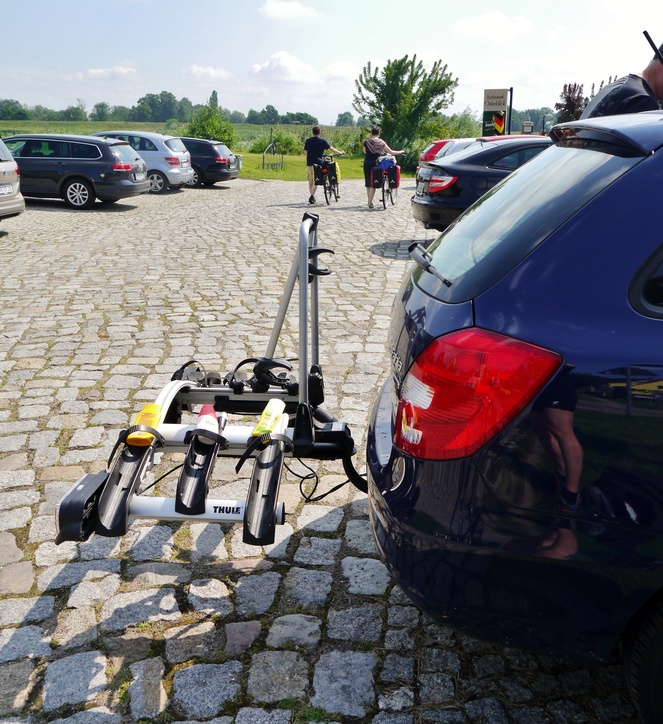 The hatchback carrier is installed on the rear of the car. It is considerably more stable than a roof rack with adequate options for fixing bicycles, allowing for transport of heavier bikes. Ideal are the hatchback racks with a foldable carrier. They make the car shorter when no bicycles are transported. Its disadvantage is the considerably higher fuel consumption of up to 20 percent. The stability of the hatchback lid hinges should be checked as they suffer considerable strain by the weight of the rack and bicycles. It is advisable to check the compatibility of the hatchback carrier with the car. Tension straps are often used in combination with a hatchback rack. They are attached to the hatchback lid. A hatchback rack limits the rear view. The driving quality hardly changes.
The hatchback carrier is installed on the rear of the car. It is considerably more stable than a roof rack with adequate options for fixing bicycles, allowing for transport of heavier bikes. Ideal are the hatchback racks with a foldable carrier. They make the car shorter when no bicycles are transported. Its disadvantage is the considerably higher fuel consumption of up to 20 percent. The stability of the hatchback lid hinges should be checked as they suffer considerable strain by the weight of the rack and bicycles. It is advisable to check the compatibility of the hatchback carrier with the car. Tension straps are often used in combination with a hatchback rack. They are attached to the hatchback lid. A hatchback rack limits the rear view. The driving quality hardly changes.
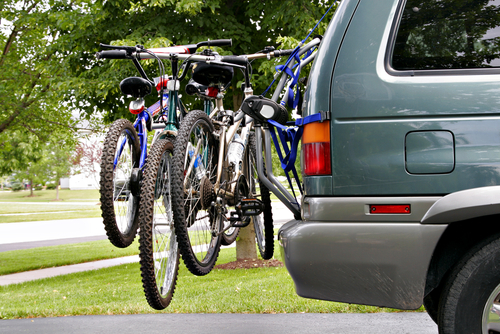 A hatchback rack can support up to three bicycles. Most carriers are easy to install. Rear lights and number plate are not covered.
A hatchback rack can support up to three bicycles. Most carriers are easy to install. Rear lights and number plate are not covered.
Opening the hatchback with a loaded bicycle rack can be problematic. When installing the rack please take care not to scratch the paintwork.
Tow-bar bike racks:
practical though somewhat unstable
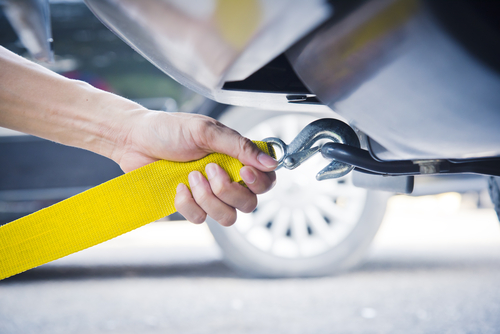 Tow-bar carriers are placed relatively low, which makes loading and unloading easier. Condition for their use is a tow bar on the car. The bicycle size should be taken into consideration. Fitting more than one broad bicycle onto the carrier could be problematic. In some countries, a warning sign is mandatory for this type of carrier. Furthermore, braking lights, rear lights and licence plate must be visible. The bicycles are allowed to protrude 400 mm sideways. The rear view can be impeded.
Tow-bar carriers are placed relatively low, which makes loading and unloading easier. Condition for their use is a tow bar on the car. The bicycle size should be taken into consideration. Fitting more than one broad bicycle onto the carrier could be problematic. In some countries, a warning sign is mandatory for this type of carrier. Furthermore, braking lights, rear lights and licence plate must be visible. The bicycles are allowed to protrude 400 mm sideways. The rear view can be impeded.
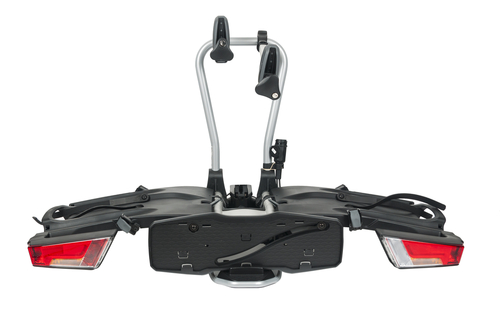 Tow-bar carriers are mounted onto the tow-bar ball. They allow for quick and simple installation and can be used irrespective of car model and brand. Tow-bar carriers are mounted with clamping bolts or a tension lever. Tow-bar carriers are not an obstacle for opening the hatchback as a loaded carrier can be folded backwards. They can carry up to three bicycles. The tow-bar carrier can be extended with an additional rail. A fourth bicycle requires a separate belt.
Tow-bar carriers are mounted onto the tow-bar ball. They allow for quick and simple installation and can be used irrespective of car model and brand. Tow-bar carriers are mounted with clamping bolts or a tension lever. Tow-bar carriers are not an obstacle for opening the hatchback as a loaded carrier can be folded backwards. They can carry up to three bicycles. The tow-bar carrier can be extended with an additional rail. A fourth bicycle requires a separate belt.
With a tow-bar carrier, bicycles weighing up to 30 kg can be transported. Fuel consumption is likely to rise by 10 percent. The tow-bar carrier extends the car length with up to 60 cm.
Please note: the entire weight of the bicycles rests on one point. The installation of the tow-bar carrier should be carried out in a professional and correct manner.
Bicycle rack accessories
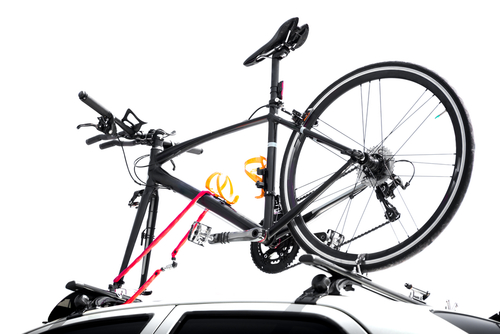 Depending on manufacturer and construction of the bicycle carrier several accessories are available, like additional fabric safety belts. They are applied to the rails to secure the bicycle. The frame holder has a similar function, fixing the bicycle to the carrier with its lock. The lockable frame holder is an additional theft security as well.
Depending on manufacturer and construction of the bicycle carrier several accessories are available, like additional fabric safety belts. They are applied to the rails to secure the bicycle. The frame holder has a similar function, fixing the bicycle to the carrier with its lock. The lockable frame holder is an additional theft security as well.
For loading and unloading, bicycle-carrier manufacturers supply loading ramps, enabling an easy parking of the bicycles on the hatchback and tow-bar carriers. Extra rear lights offer additional protection and safety in road traffic. For their power supply, separate sockets are available. The additional lighting can be retrofitted as well.
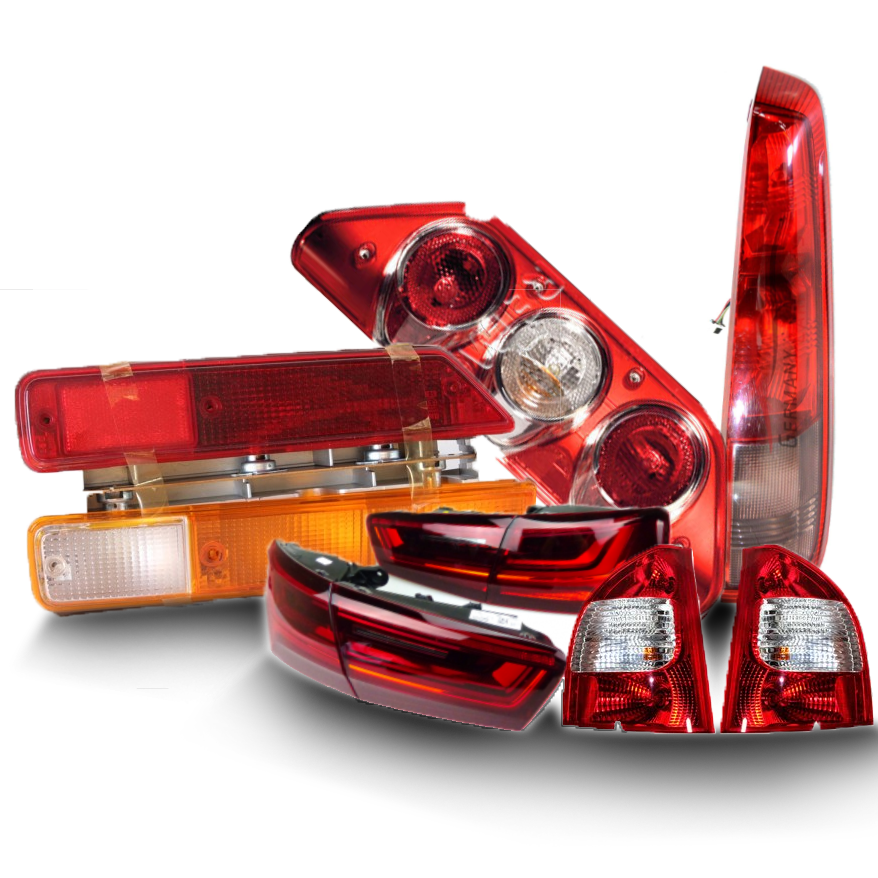
Tail lights with 50% discountfree of shipping costsOrder now ⇒ |
A wall rack serves as a storage for the bicycle carrier when it is out of service. The racks save space and are suitable for a garage or basement.
Regular accessories for roof carriers are transport boxes which can be mounted on the bicycle carrier. These are available for hatchback and tow-bar carriers. They extend the use of the bicycle carrier, enabling transport of other objects as well.
Installing bicycle carriers
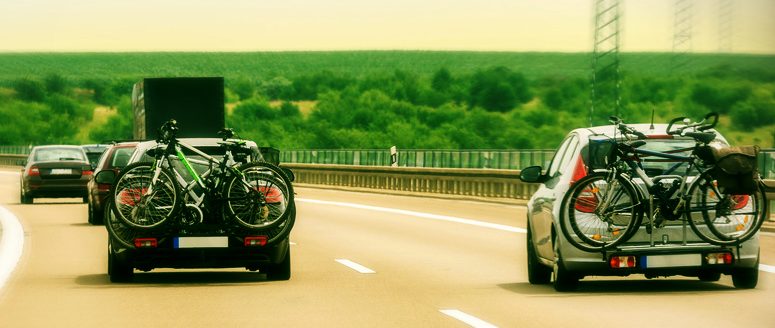 No matter if on the roof, the hatchback or the tow bar, mounting a bicycle carrier must always be performed according to the manufacturer’s specifications. If at purchase of a used bicycle carrier the installation manual is no longer available, it can be downloaded from the internet. This also allows you to check for possible missing parts. Only a correctly installed bicycle carrier is a safe bicycle carrier. Every negligence irrevocably leads to dangerous situations. Therefore read the manual several times and arrive safely at your holiday destination with your bicycles.
No matter if on the roof, the hatchback or the tow bar, mounting a bicycle carrier must always be performed according to the manufacturer’s specifications. If at purchase of a used bicycle carrier the installation manual is no longer available, it can be downloaded from the internet. This also allows you to check for possible missing parts. Only a correctly installed bicycle carrier is a safe bicycle carrier. Every negligence irrevocably leads to dangerous situations. Therefore read the manual several times and arrive safely at your holiday destination with your bicycles.
Foto: Naypong, Golden Sikorka, Ralf Geithe, Björn Wylezich, Clarini, Sergiy Zavgorodny, PATIWIT HONGSANG, LoopAll, Flashon Studio, Gargantiopa, Goran Bogicevic, Bignai / shutterstock.com

